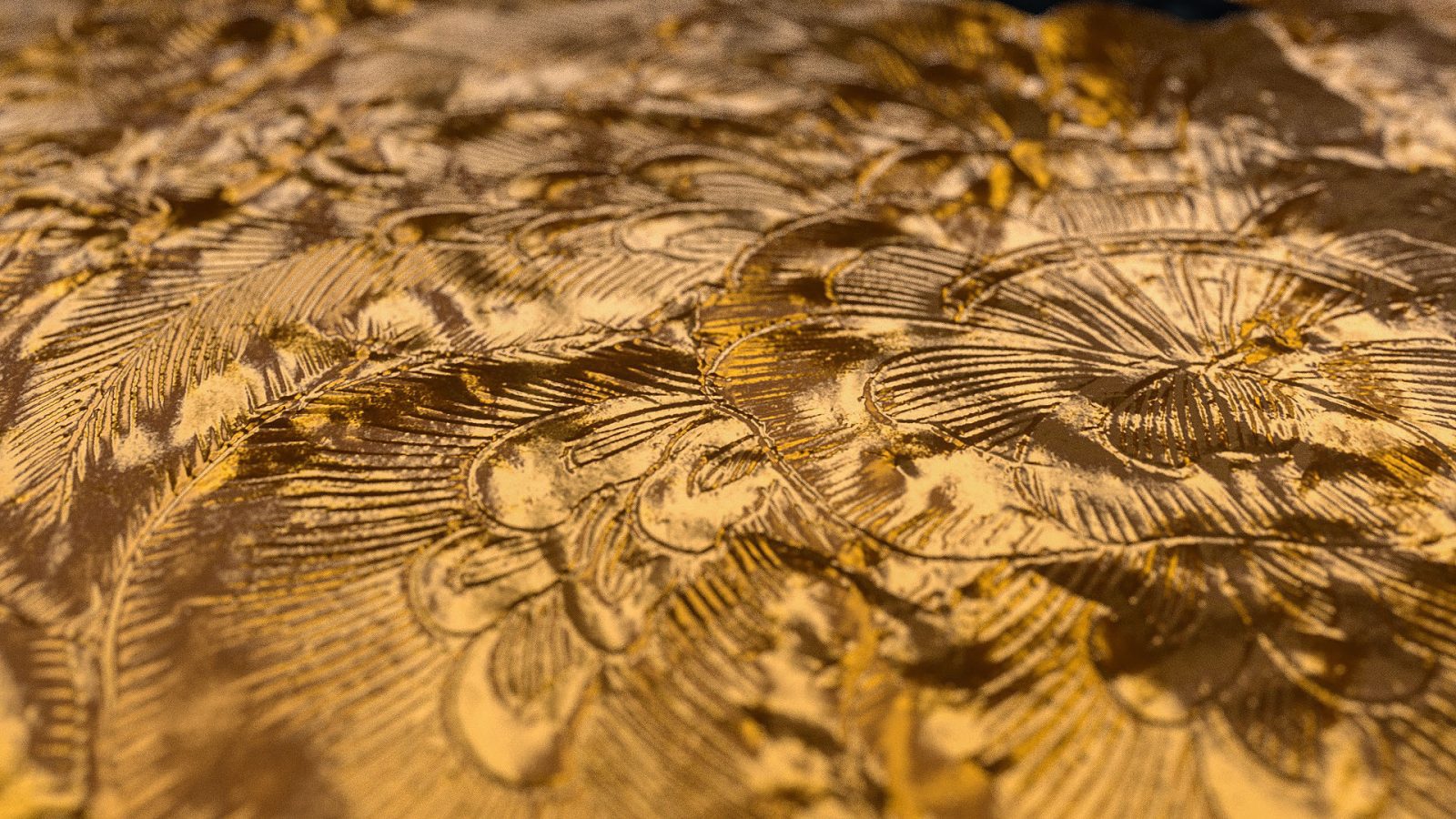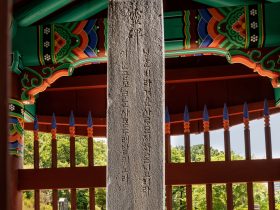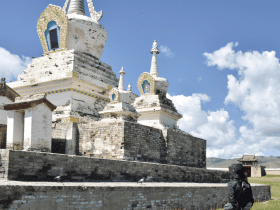Gyeongju National Research Institute of Cultural Heritage
Kim, Gyeongyeol




The Donggung Palace and Wolji Pond in Gyeongju is a royal palace site consisting of a garden and a villa for crown prince, built in the 14th year (674) and the 19th year (679) of King Munmu’s reign respectively. Namely the center of Silla’s royal capital, it is an important site representing the rise and fall of Unified Silla.
Recently, a gold leaf engraved with blooming flowers and two birds design recovered from the east site made the headlines. The keyword for this object is minuteness. Could anything be more detailed than this? Hundreds of lines with a thickness around 0.04 to 0.05 millimeters are carved on the gold leaf, 3.6 centimeters wide and 1.17 centimeters long.
We will take a closer look at this gold leaf in four themes. First, its dramatic excavation circumstances; second, detailed carving; third, production technique and the carved pattern; fourth, the significance of the gold leaf in the history of Silla’s metal crafts.
1. Dramatic Excavation Circumstances
In late October, 2016, an excavation worker urgently called an investigator at the site. An artifact in the size of a red bean, mixed with dirt, glittered like gold, and it was documented for treatment. Ten days later, a similar object was found in another grid about 20 meters away.
This was how the gold leaf artifact was found and excavated. Two pieces of gold leaves, found in a miraculous excavation process, were joined with each other during conservation treatment and confirmed to be one object. At the same time, very detailed pattern was engraved on the gold leaf. The gold leaf is 3.6 centimeters wide, 1.17 centimeters long and 0.04 millimeters thick with a weight of 0.3 grams. The thickness of lines on the gold leaf was only 0.05 millimeters. Hundreds of the lines formed ssangjomun, or a pattern of a pair of birds facing flowers. Without the meticulous excavation process by the field workers and our researchers, the gold leaf may not be with us now.
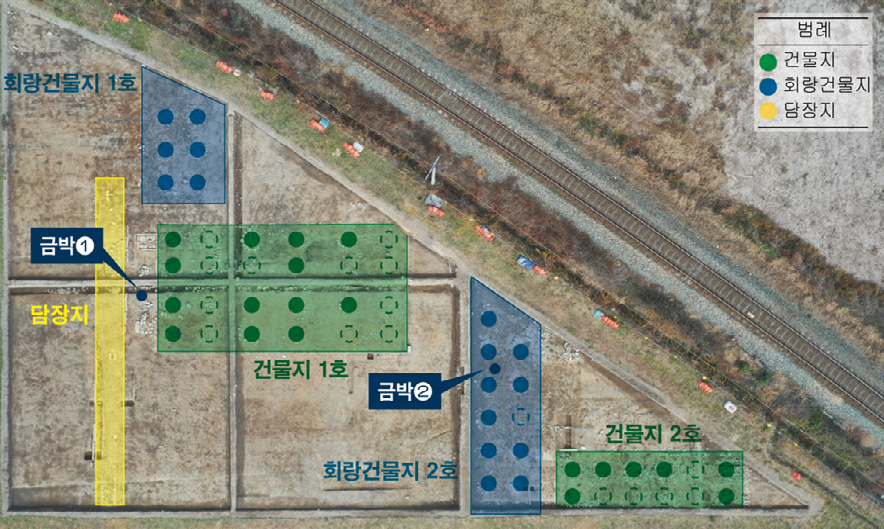

2. 0.05mm Lines Engraved on 0.04mm-thick Gold Leaf
The keyword for the gold leaf found in the site is delicateness. The average human hair is about 0.08 millimeters thick and carving a pattern with lines in a thickness of 0.05 millimeters, which is thinner than hair, is at the pinnacle of detailedness. Among the modern technologies that represent detail is semiconductor manufacturing. The fine process of semiconductor making is conducted in nanoscale and the modern semiconductor manufacturing technology could replicate the fine patterns on the gold leaf. However, the important point is that micro-scale detailed patterns were engraved on gold leaf during the Unified Silla period. Therefore, it can be said that, among the relics identified so far, the detail of the engraving is in the highest level ever. According to the analyses conducted up to now, it seems that the pattern was engraved with a very fine stylus or chisel by applying gold leaf to a certain object. However, there is a debate among experts over whether it was the line is drawn or chiseled into. As seen in the electron microscope analysis results, there are traces of gold pushed inside the line (the shape of the bean pod) and it shows that the line was not punched in or drawn with a single stroke. Therefore, considering the convenience for engraving the pattern, it seems a little more likely that it was drawn.
The patterns engraved on the gold leaf like this is almost impossible to recognize without a magnifying glass. If so, questions such as ‘Did they engrave such elaborate patterns with a magnifying glass?’ or ‘Was this carved with the extraordinary sense of the unknown Silla craftsman?’ arise.
It is presumed that the patterns were engraved using a magnifying glass, but unfortunately, the magnifying glass of this period has not been identified in Korea to date. Some estimate that the crystal lens found in the Bunhwangsa Temple site in Gyeongju as a magnifying glass, but considering the shape of the lens and its magnifications, it is unlikely that it was used as a magnifying glass. However, the fact that the crystal was processed in the form of a convex lens shows that the people of Silla understood the concept of condensing lens from the optical perspective and also likely to have known the concept of magnifying at the time. Therefore, although an actual magnifying glass has not been found archaeologically as of now, it is reasonable to assume that the magnifying glass or a similar tool was made and used to engrave patterns on the object. This is also supported by the patterns as there are some mistakes found, but the amount is very small compared to the total number of the lines and there are almost no overlaps of many lines of the pattern, thus it is considered that the magnifying glass was used to carve the patterns.


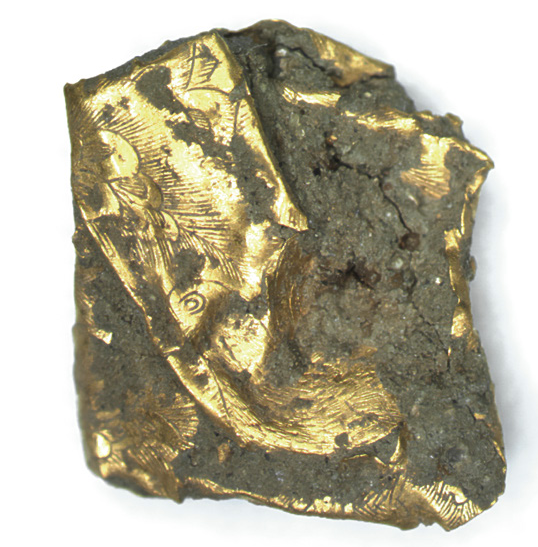



3. Production Technique and Flowers and Birds Engraved on Gold Leaf
A notable part of the gold leaf’s production method is that the patterns were carved on a large gold leaf first, then only the necessary parts were cut and used. This is highly assumed because the cut off traces of the engraved patterns are found on the artifact as well as the edges are slightly curled due to its cutting. Therefore, it is estimated that the current shape, which is an indeterminate form close to a trapezoid, is a finished product. There is no hole to be found for the hanging purposes, so it seems that it was directly attached to an object; however, there are no traces of pigment nor foreign substances found on the back side of the object.
The type of bird engraved on the object appears to be a turtle dove. The slightly protruding forehead; the protruding cere from the forehead to the beak; the typical toe shape of a forest bird without webbing and toes developed from the first to the fourth one; the characteristic shapes of the body and tail feathers and the body to wing ratio are the reasons for considering it to be a turtle dove. Turtle doves often symbolize conjugal harmony because a male and female pair always travel together, but it is difficult to understand the exact meaning of the pattern at the moment as the symbolic meaning of a pattern continues to change according to the times and regions. Interestingly, it is very likely that the birds drawn on the gold leaf represent a male and a female. If you observe the bird drawn on the left and the bird on the right, you can see the differences. The shape of the neck feathers, the direction of the tail, and the direction in which the tail feathers are engraved are different. The bird on the right has more neck feathers than the left and the tail is downwards with the tail feathers pointing downwards. Since the pattern is so detailed, it is likely that these differences reflected some significance. Normally the male and female doves are distinguished by pressing the head of the bird or slightly shaking the bird in order to confirm the female’s tail going up and the male’s tail going down for the purpose of mating. So, it is most likely that the bird on the left side is female and on the right side is male.
The flower carved on the gold leaf is known as danhwa, which literally refers to round flower. It is an imaginary flower design popular during the Unified Silla period and is also found in objects excavated from the Hwangnyongsa Temple site and the Garden Site in Guhwang-dong, Gyeongju.
The pattern carved on the gold leaf is a typical symmetrical ssangjomun (a pattern of a pair of birds). This pattern is easily found in roof tiles from the Unified Silla period. The shape of the pattern suggests that the gold leaf dates to the 8th century. Many researchers have suggested that the ssangjomun is originated from Sassanid Persia and introduced to the Korean Peninsula via China. However, the gold leaf from the site is depicted very realistically, while the patterns found in the Sassanid or China are rather formal. Therefore, we can presume that this is the indigenized Silla style.


5. The trace of a mistake by the artisan


7. Details of the engraved patterns.
4. Significance of the Gold Leaf in Metal Craft History
First, this gold leaf was made of ultra-high purity gold. The electron microscope analysis found that other elements are close to zero percent. It is close to the true meaning of pure gold. Nowadays, with the development of refining technology, it is not difficult to manufacture 99.99wt% of pure gold. However, the fact that technology for pure gold production continues to be developed even now indicates that the technology is not so easy to achieve. Gold is a highly malleable and ductile metal due to the presence of many free electrons in its material properties. So it would not have been so difficult to pound and flatten pure gold wide and thin, but refining high purity gold would have been very difficult. There were very few gold objects made of pure gold during that time (This may be due to the hardness of gold metal was problematic for the practical use). For the reference, the average purity of gold crowns excavated from wooden chamber tombs with stone mound of Silla is around 80-89% (19.3k-21.1k).
Second, the ssangjomun pattern is described in a very realistic way. Ssangjomun designs recovered from the Korean Peninsula are often formal or added with imaginary elements. However, this object is very realistic. A relic with similar design is the silver Buddhist urn engraved with flower and bird design, presumed to be collected from the Hwangnyongsa Temple site in Gyeongju.
It seems that level of realistic expression can be evaluated not only in the field of metal crafts, but also in the field of fine art of Silla. Paintings and drawings from Silla period are rare and metal crafts in this level of realistic expression are hard to find as well. The use or function of the gold leaf is not clarified yet, because no similar object was ever excavated in Korea nor abroad. However, the general consensus is that this gold leaf is probably for the utopia or for gods rather than functioning as decoration. If it were to be a decoration, the patterns should have been visible.
This precious object is now on display at a special exhibition “The Blooming Flowers and Birds on 3 centimeter Gold Leaf” at Cheonjongo Special Exhibition Room of the Gyeongju National Research Institute of Cultural Heritage. The exhibition is closed on weekends and holidays, but is available at the official website of the Gyeongju National Research Institute of Cultural Heritage.



